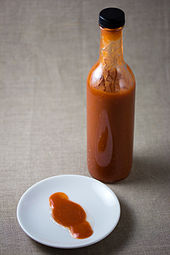

Hot sauce is a type of condiment, seasoning, or salsa made from chili peppers and other ingredients. Many commercial varieties of mass-produced hot sauce exist.


Hot sauce is a type of condiment, seasoning, or salsa made from chili peppers and other ingredients. Many commercial varieties of mass-produced hot sauce exist.
Humans have used chili peppers and other hot spices for thousands of years. [1] One of the first commercially available bottled hot sauces in the United States appeared in 1807 in Massachusetts. [2] However, few of the early brands from the 1800s survived to this day. Tabasco sauce is the earliest recognizable brand in the United States hot sauce industry, appearing in 1868. As of 2010, it was the 13th best-selling seasoning in the United States [3] preceded by Frank's RedHot Sauce in 12th place, which was the sauce first used to create buffalo wings. [4]
Many recipes for hot sauces exist, but the only common ingredient is some variety of chili pepper. Many hot sauces are made by using chili peppers as the base and can be as simple as adding salt and vinegar. Other sauces use some type of fruits or vegetables as the base and add the chili peppers to make them hot. [5] Manufacturers use many different processes from aging in containers to pureeing and cooking the ingredients to achieve a desired flavor. Because of their ratings on the Scoville scale, spicier peppers such as the Ghost pepper, Scotch bonnet or Habanero pepper are sometimes used to make hotter sauces. Alternatively, other ingredients can be used to add extra heat, such as pure capsaicin extract or mustard oil. Other common sauce ingredients include vinegar and spices. Vinegar is used primarily as a natural preservative, but flavored vinegars can be used to alter the flavour. [6]
This section needs additional citations for verification .(October 2019) |
Belizean hot sauces are usually extremely hot and use habaneros, carrots, and onions as primary ingredients. Marie Sharp's is a popular brand of hot sauce produced in the Stann Creek Valley.
Bermudian sherry peppers sauce is made from a base of Spanish sherry wine and hot peppers. The major producer on the island is Outerbridge Peppers. [7] [8]
Hot pepper sauces, as they are most commonly known there, feature heavily in Caribbean cuisine. They are prepared from chilli peppers and vinegar, with fruits and vegetables added for extra flavor. The most common peppers used are habanero and Scotch bonnet, the latter being the most common in Jamaica. Both are very hot peppers, making for strong sauces. Over the years, each island developed its own distinctive recipes, and home-made sauces are still common.[ citation needed ]
Trinidad Scorpion is considered one of the hottest and most frutal families of strains, and is primarily cultivated and hybridized in the United States, United Kingdom, and Australia.
Bajan pepper sauce, a mustard and Scotch bonnet pepper based hot sauce.
Sauce Ti-malice, typically made with habanero, shallots, lime juice, garlic and sometimes tomatoes [9]

Sofrito—small piquins ("bird peppers") with annatto seeds, coriander leaves, onions, garlic, and tomatoes. Pique ( /ˈpiːk/ ) sauce is a Puerto Rican hot sauce made by steeping hot peppers in vinegar. Don Ricardo Original Pique Sauce, which is made with pineapple, is a Puerto Rican staple. Don Ricardo originated in Utuado (Spanish pronunciation: [uˈtwaðo]) a municipality of Puerto Rico located in the central mountainous region of the island known as La Cordillera Central.
Scotch bonnets are the most popular peppers used in Jamaica. Pickapeppa sauce is a Jamaican sauce.
The most popular sauce is the Diaguitas brand, made of pure red (very hot) or yellow (hot) Chilean peppers mixed only with water and salt. Other hot sauces are made from puta madre, cacho de cabra, rocoto, oro and cristal peppers, mixed with various ingredients. Mild hot sauces include some "creamy style" (like ají crema), or a pebre-style sauce, from many local producers, varying in hotness and quality.
Mexican cuisine more often includes chopped chili peppers, but when hot sauces are used, they are typically focused more on flavor than on intense heat. Chipotle peppers are a very popular ingredient of Mexican hot sauce. Vinegar is used sparingly or not at all in Mexican sauces, but some particular styles are high in vinegar content similar to the American Louisiana-style sauces. Some hot sauces may include using the seeds from the popular achiote plant for coloring or a slight flavor additive. The process of adobos (marinade) has been used in the past as a preservative but now it is mainly used to enhance the flavor of the peppers and they rely more on the use of vinegar. Mexican-style sauces are primarily produced in Mexico but they are also produced internationally. The Spanish term for sauce is salsa, and in English-speaking countries usually refers to the often tomato-based, hot sauces typical of Mexican cuisine, particularly those used as dips. There are many types of salsa which usually vary throughout Latin America.
These are some of the notable companies producing Mexican style hot sauce.
Traditional Panamanian hot sauce is usually made with "Aji Chombo", Scotch Bonnet peppers. Picante Chombo D'Elidas is a popular brand in Panama, with three major sauces. The yellow sauce, made with habanero and mustard, is the most distinctive. They also produce red and green varieties which are heavier on vinegar content and without mustard. Although the majority of Panamanian cuisine lacks in spice, D'Elidas is seen as an authentic Panamanian hot sauce usually serviced with Rice with Chicken or soups.
In the United States, commercially produced chili sauces are assigned various grades per their quality. [10] These grades include U.S. Grade A (also known as U.S. Fancy), U.S. Grade C (also known as U.S. Standard) and Substandard. [10] Criteria in food grading for chili sauces in the U.S. includes coloration, consistency, character, absence of defects and flavor. [10]

The varieties of peppers that are used often are cayenne, chipotle, habanero and jalapeño. Some hot sauces, notably Tabasco sauce, are aged in wooden casks similar to the preparation of wine and fermented vinegar. Other ingredients, including fruits and vegetables such as raspberries, mangoes, carrots, and chayote squash are sometimes used to add flavor, mellow the heat of the chilis, and thicken the sauce's consistency. Artisan hot sauces are manufactured by smaller producers and private labels in the United States. Their products are produced in smaller quantities in a variety of flavors. Many sauces have a theme to catch consumers attention. A very mild chili sauce is produced by Heinz and other manufacturers, and is frequently found in cookbooks in the U.S. This style chili sauce is based on tomatoes, green and/or red bell peppers, and spices; and contains little chili pepper. This sauce is more akin to tomato ketchup and cocktail sauce than predominantly chili pepper-based sauces. [11]
A type of sriracha sauce manufactured in California by Huy Fong Foods has become increasingly popular in the United States in contemporary times. [12]
Louisiana-style hot sauce contains red chili peppers (tabasco and/or cayenne are the most popular), vinegar and salt. Occasionally xanthan gum or other thickeners are used.
New Mexico chile sauces differ from others in that they contain no vinegar. Almost every traditional New Mexican dish is served with red or green chile sauce, the towns of Hatch, Chimayo, the Albuquerque area, and others in New Mexico are well known for their peppers. The sauce is often added to meats, eggs, vegetables, breads, and some dishes are, in fact, mostly chile sauce with a modest addition of pork, beef, or beans.
The availability of a wide variety of hot sauces is a relatively recent event in most of Australia. Pre 2000, there was little more choice than the flagship brand of Tabasco Cayenne sauce predominantly used in restaurants and sold in supermarkets. Other options included the more specialised thick, medium to hot Asian sauces, [ citation needed ]. Although today, two of the most popular picks are the Buffalo and Sriracha hot sauces. There's also very faithful, locally produced versions of Habanero and Trinidad Scorpion ranges available.
Two of the hottest chilies in the world, the Naga Viper and Infinity chili were developed in the United Kingdom[ citation needed ] and are available as sauces which have been claimed to be the hottest natural chili sauces (without added pepper extract) available in the world. [15] [ failed verification ] The Naga Viper and Infinity were considered the hottest two chili peppers in the world until the Naga Viper was unseated by the Trinidad Moruga Scorpion in late 2011.[ citation needed ]

The heat, or burning sensation, experienced when consuming hot sauce is caused by capsaicin and related capsaicinoids. The burning sensation is caused by the capsaicin activation of the TRPV1 heat and ligand-gated ion channel in peripheral neurons. [16] The mechanism of action is then a chemical interaction with the neurological system. Although the "burning" sensation doesn't correspond to a real stimulus, repeated and prolonged use of hot spices may harm the peripheral heat-sensing neurons; this mechanism may explain why frequent spice users become less sensitive to both spices and heat.
Foods containing capsaicin, like hot sauces, can have different effects on each individual. Those with stomach issues can experience worse symptoms than just the “burning” sensation. People with irritable bowel syndrome (IBS) can have gas, diarrhea, or stomach pains after ingesting hot sauces. [17]
The seemingly subjective perceived heat of hot sauces can be measured by the Scoville scale. The Scoville scale number indicates how many times something must be diluted with an equal volume of water until people can no longer feel any sensation from the capsaicin. The hottest hot sauce scientifically possible is one rated at 16 million Scoville units, which is pure capsaicin. An example of a hot sauce marketed as achieving this level of heat is Blair's 16 Million Reserve, marketed by Blair's Sauces and Snacks. By comparison, Tabasco sauce is rated between 2,500 and 5,000 Scoville units (batches vary) - with one of the mildest commercially available sauces, Cackalacky Classic Sauce Company's Spice Sauce, weighing in at less than 1000 Scoville units on the standard heat scale.
A general way to estimate the heat of a sauce is to look at the ingredients list. Sauces tend to vary in heat based on the kind of peppers used, and the further down the list, the less the amount of pepper.
Capsaicinoids are the chemicals responsible for the "hot" taste of chili peppers. They are fat soluble and therefore water will be of no assistance when countering the burn. The most effective way to relieve the burning sensation is with dairy products, such as milk and yogurt. A protein called casein occurs in dairy products which binds to the capsaicin, effectively making it less available to "burn" the mouth, and the milk fat helps keep it in suspension. Rice is also useful for mitigating the impact, especially when it is included with a mouthful of the hot food. These foods are typically included in the cuisine of cultures that specialise in the use of chilis. Mechanical stimulation of the mouth by chewing food will also partially mask the pain sensation. [22]

Tabasco is an American brand of hot sauce made from tabasco peppers, vinegar and salt. It is produced by McIlhenny Company of Avery Island in south Louisiana, having been created over 150 years ago by Edmund McIlhenny. Although the tabasco peppers used in the sauce were initially grown only on Avery Island, they are now primarily cultivated in Central America, South America and Africa. The Tabasco sauce brand also has multiple varieties including the original red sauce, habanero, chipotle, sriracha and Trinidad Moruga scorpion. Tabasco products are sold in more than 195 countries and territories, and packaged in 36 languages and dialects.

The Scoville scale is a measurement of pungency of chili peppers and other substances, recorded in Scoville heat units (SHU). It is based on the concentration of capsaicinoids, among which capsaicin is the predominant component.

Chili peppers, also spelled chile or chilli, are varieties of the berry-fruit of plants from the genus Capsicum, which are members of the nightshade family Solanaceae, cultivated for their pungency. Chili peppers are widely used in many cuisines as a spice to add "heat" to dishes. Capsaicin and related compounds known as capsaicinoids are the substances that give chili peppers their intensity when ingested or applied topically. Chili peppers exhibit a range of heat and flavors. This diversity is the reason behind the availability of different types of paprika and chili powder, each offering its own taste and heat level.

Scotch bonnet is a variety of chili pepper named for its supposed resemblance to a Scottish tam o' shanter bonnet. It is ubiquitous in West Africa and the Caribbean.
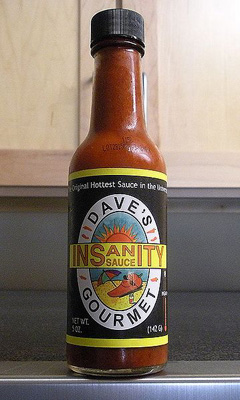
Dave's Gourmet is a company notable for creating and introducing Dave's Insanity Sauce, which formerly held the title of "world's hottest sauce." The sauce is widely distributed through gourmet hot sauce boutiques and online hot-sauce sites.

Capsicum chinense, commonly known as a "habanero-type pepper", is a species of chili pepper native to the Americas. C. chinense varieties are well known for their unique flavors and many have exceptional heat. The hottest peppers in the world are members of this species, with a Scoville Heat Unit score of 2.69 million measured in the C. chinense cultivar, Pepper X in 2023.

The Red Savina pepper is a cultivar of the habanero chili, which has been selectively bred to produce spicier, heavier, and larger fruit, ultimately more potent than its derivative.

The poblano is a mild chili pepper originating in the state of Puebla, Mexico. Dried, it is called ancho or chile ancho, from the Spanish word ancho ("wide"). Stuffed fresh and roasted it is popular in chiles rellenos poblanos.
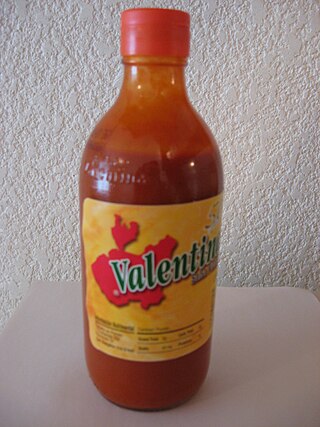
Valentina is a hot sauce brand manufactured by Salsa Tamazula, a company based in Guadalajara, Mexico. Like the parent company's Tamazula hot sauce, Valentina is made with puya chilis from Jalisco state, similar to the Guajillo chili and known by the name guajillo puya.
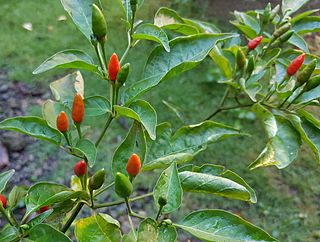
Siling labuyo is a small chili pepper cultivar that developed in the Philippines after the Columbian Exchange. It belongs to the species Capsicum frutescens and is characterized by triangular fruits that grow pointing upwards. The fruits and leaves are used in traditional Philippine cuisine. The fruit is pungent, ranking at 80,000 to 100,000 heat units in the Scoville Scale.

A guajillo chili or guajillo chile or chile guaco or mirasol chile is a landrace variety of the species Capsicum annuum with a mirasol chile fruit type. Mirasol is used to refer to the fresh pepper, and the term guajillo is used for the dry form, which is the second-most common dried chili in Mexican cuisine. The Mexican state of Zacatecas is one of the main producers of guajillo chilies. There are two main varieties that are distinguished by their size and heat factors. The guajillo puya is the smaller and hotter of the two. In contrast, the longer and wider guajillo has a more pronounced, richer flavor and is somewhat less spicy. With a rating of 2,500 to 5,000 on the Scoville scale, its heat is considered mild to medium.

The ghost pepper, also known as bhut jolokia, is an interspecific hybrid chili pepper cultivated in Northeast India. It is a hybrid of Capsicum chinense and Capsicum frutescens.
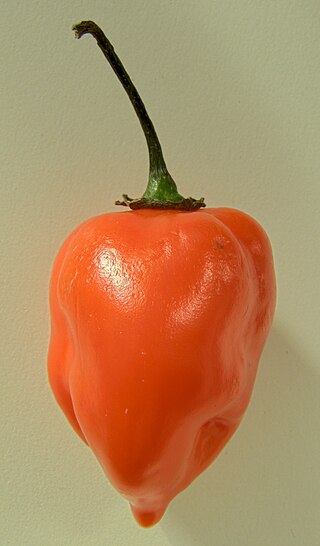
The hot pepper challenge is an Internet viral video fad, consisting of a food challenge that involves filming oneself while eating and swallowing a chili pepper that is high on the Scoville scale and known for its piquant (spicy-hot) qualities, in particular the cayenne pepper, Thai pepper, habanero, ghost pepper, and the Trinidad moruga scorpion pepper; the video is then uploaded to the Internet. Hot pepper challenges have been featured on television series, including Man v. Food.

Pique is a traditional hot sauce from Puerto Rico that is typically made with a variety of chili peppers, garlic, and spices. It is often made by fermenting the ingredients, which can give it a unique flavor profile and a more complex taste. Some variations may include ingredients such as cilantro, oregano, or onions. Pique is commonly used as a condiment for a variety of traditional Puerto Rican dishes such as rice, beans, and meat dishes. It can also be used as a marinade for meats or as a dip for tostones or other fried foods. Pique is a staple condiment in Puerto Rico and is often homemade, but can also be found in grocery stores.

Capsicum is a genus of flowering plants in the nightshade family Solanaceae, native to the Americas, cultivated worldwide for their edible fruit. Bell peppers, sweet peppers and some chili peppers belong to the Capsicum annuum species, making it the most cultivated species from the genus.

The habanero is a hot variety of chili. Unripe habaneros are green, and they color as they mature. The most common color variants are orange and red, but the fruit may also be white, brown, yellow, green, or purple. Typically, a ripe habanero is 2–6 centimetres long. Habanero chilis are very hot, rated 100,000–350,000 on the Scoville scale. The habanero heat, flavor, and floral aroma make it a common ingredient in hot sauces and other spicy foods.
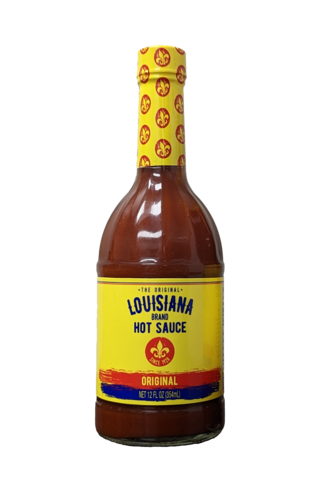
The Original Louisiana Brand Hot Sauce is a brand of hot sauce manufactured in New Iberia, Louisiana by Summit Hill Foods. Bruce Foods was the previous owner and manufacturer of the brand and sold it to Summit Hill Foods in April 2015.

Especially among growers in the US, the UK, and Australia, there has been a competition since the 1990s to grow the hottest chili pepper. Chili pepper species and cultivars registering over 1,000,000 Scoville Heat units (SHU) are called "super-hots". Past Guinness World Record holders include the ghost pepper, Infinity chili, Trinidad Moruga scorpion, Naga Viper pepper, Trinidad Scorpion Butch T, and Carolina Reaper. The current record holder, declared in 2023, is Pepper X, at more than 2.69 million SHU.